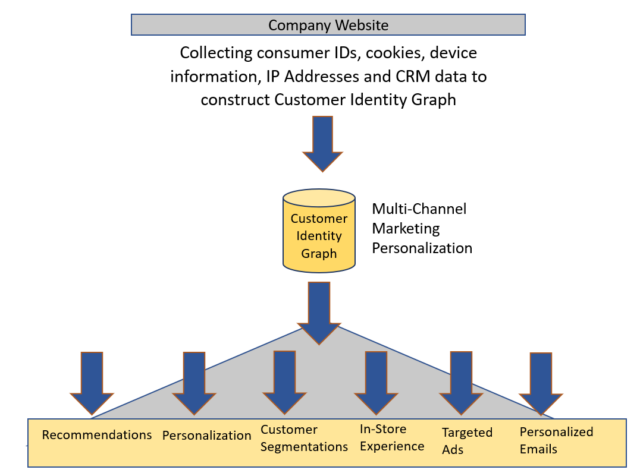Enabling Greater Digital Personalization with Graph
- December 15, 2022
This blog is co-authored by Gaurav Chawla, Vice President and Dell Fellow, Infrastructure Solutions Group, Dell Technologies.
Graph technology will be a critical component of future data management architectures that involve the integration of multiple datasets with relationships across the data elements. Graph databases and graph algorithms enable efficient storage, retrieval and processing of data that is interconnected in a complex manner. This technology will provide the ability to query and analyze data in ways that are not possible with traditional relational database systems and enable users to glean powerful insights from the data. Gartner predicts that by 2025, “graph technologies will be used in 80% of data and analytics innovations, up from 10% in 2021.”
Graph technology uses a graph data structure for data storage and management. It is a common choice for dealing with connected data, such as social networks, financial transactions and other complex networks.
Graph databases are designed to be efficient and scalable and are used in applications that require fast and flexible data access. Graph technology has several applications in various industries. In healthcare, graph technology can help store and analyze complex patient data, such as medical records, to identify relationships between different treatments, illnesses and effectiveness of treatments across patients. Financial services organizations can use graph databases to identify potential fraud by analyzing transactions and customer data. Social media professionals can use graph technology to identify influencers and trends. And in cybersecurity, graph technology helps detect anomalies and threats.
Overall, Graph technology is a powerful tool for managing and analyzing complex datasets with multi-dimensional relationships. Its scalability and flexibility make it a fitting choice for applications that require fast and flexible data analytics.
Digital personalization is just one example that benefits from using Graph technology. Companies need innovative ways to target website visitors with relevant and personalized content. To deliver personalized content, companies need to perform data analysis to segment shoppers, display relevant advertisements and trigger personalized email drip campaigns for different shopper segments.
Historically, websites tracked visitors across multiple domains using third-party cookies. However, third-party cookies posed several downsides, including security and privacy concerns, loss of control, potential for retargeting, limited data accuracy and limited reach. Several browsers have already phased out third-party cookies, while the remaining browsers are in the process of doing so. This change will significantly impact the way companies deliver personalized content to their online shoppers.
This makes it imperative for companies to utilize a modern technology utilizing Graph. Graphs capture relationships and connections between data entities, which are then used for data analysis and decision-making. Because data is so connected, graphs are becoming increasingly important by making it easier to explore those connections and draw new conclusions.
When companies utilize a Graph Analytics approach, they are less reliant on third-party cookies, while also addressing the growing need for building a 360-degree view of consumers and analyzing them across other applicable business units and datasets. There are several data sources to utilize to develop the graph for building personalization capabilities, including inventory data, consumer browsing history, transactions (e.g., CRM Data), leads (e.g., CRM Data) and proprietary data.
The following visualization outlines an approach to address current challenges while crafting a vision for graph analytics to drive all aspects of multi-channel marketing personalization.
 Why Choose a Graph Database
Why Choose a Graph DatabaseConsidering the focus on performance and TCO, two key technical aspects to consider are data modelling simplification and query performance. Regarding data modelling simplification, traditional relational databases with rigid schemas and relationships pose a challenge in building a data model for a graph problem. The data model is hard to scale if the user identifies new vertices and edges, both in terms of query performance and difficulty of writing the desired query in SQL. Modelling the data as a graph can mimic the business relationships, and this is the first indication that Graph database is a natural fit for this use case.
For query performance, Graph databases offer out-of-the-box query performance that saves time for doing any optimizations. Query performance is expected to scale as additional edges and vertices are added.
Graph technology is rapidly gaining traction in the digital personalization space. By providing an intuitive and efficient way to represent, store and query data, Graph technology enables businesses to better understand and respond to customer needs. It enables organizations to build customer profiles and link them to other related information to provide more accurate and personalized experiences, as well as to create more efficient workflows and marketing strategies.
Graph technology has been especially useful for personalization in e-commerce, where companies can use it to capture customer behavior and preferences. By leveraging a graph database and Graph-based algorithms, companies can better understand customer behavior and create personalized experiences in real-time. Companies can use graph technology to provide personalized recommendations based on customer interests and past behavior. They can also use Graph technology to detect patterns within customer data and uncover insights they can then use to improve customer experiences.
By connecting customer data points and creating 360-degree customer profiles, businesses can identify key trends and develop more effective strategies for segmentation and targeting. Graph technologies and frameworks enable intuitive and efficient representation of data, and enable insights for businesses to deliver more personalized experiences.